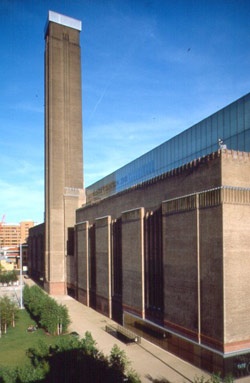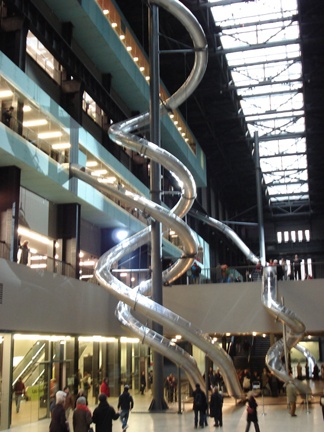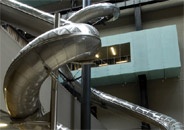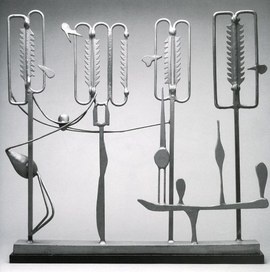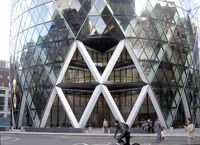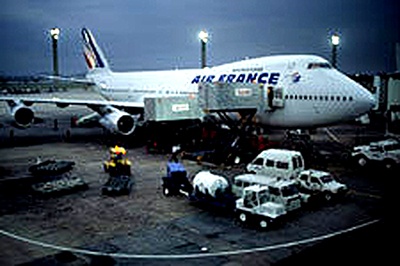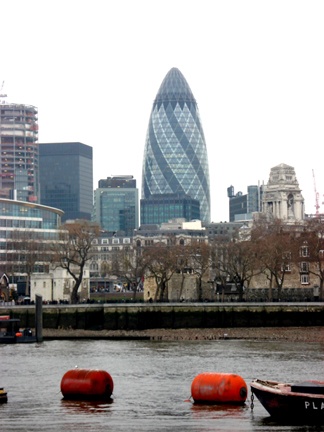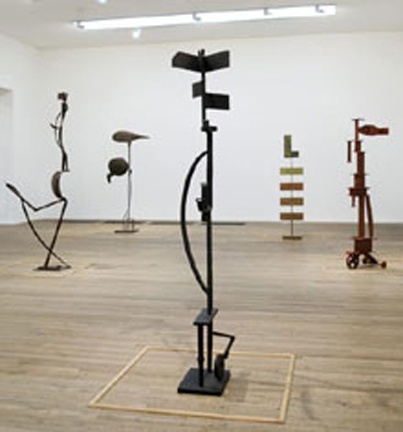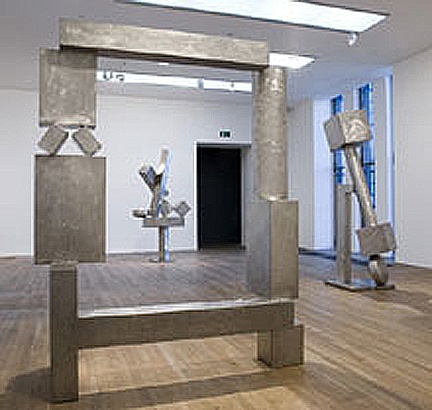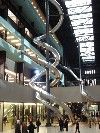London: What We Did on My Daughter's Vacation
David Smith and Carsten Holler at Tate Modern
By: Mark Favermann - Jan 08, 2007
Between Christmas and New Year's, I visited London with my daughter. This was the first time that I had been there since early September (pre 9/11) of 2001. Five years ago, I found it rather unkempt and a little dowdy, even a bit thread-worn. Then, the business energy level seemed to be high but the aesthetics low, but not this time. This time London felt almost new and full of energy.Arriving at Heathrow Airport customs, it took over an hour and a half to transverse the lines of tourists, and finally we got to our van to our hotel. Oddly, our driver was a rather unattractive middle-aged Anglo-Portuguese woman in an inappropriate miniskirt that spoke rather nonstop with a cockney accent. We shared the van with two retired teachers from Baltimore who were either amused with the silly driver's conversation or aghast by it. It was very hard to tell. As the teachers were staying near Harrods Department Store, they were dropped off first. The commentary from the driver was mostly about Man U (Manchester United) leading the Premiere League (the top soccer league in the UK), her discussions with her grown sons about the football teams that they supported (Chelsea and New Castle) and her trips to converted castle hotels with her liquor distributing partner.
As we drove into London, my daughter, a first time visitor, was charmed by the non-American look of the buildings, the signs and traffic direction. I pointed out the Victoria and Albert Museum, the Museum of Science and then Harrods. We then drove past Buckingham Palace and various other sites--Wellington Arch, Hyde Park, St. James's Park, Big Ben in the distance as well as St. Paul's Cathedral. As she had been bragging about her knowledge of London, I asked the driver about "The Gherkin." She pretended to know what I was talking about. I saw puzzlement cloud her face.
I tried to explain it, but finally, I pointed it out on the London skyline. The forty-story building designed by Sir Norman Foster (the Boston MFA architect of museum expansion) and his ex-partner Ken Shuttleworth of Foster and Partners, was constructed between 2001 and 2004. It was built at the former site of the Baltic Exchange, which had been blown up by the Provisional Irish Republic an Army by a bomb detonated near by. Initially, the building was to be three times larger and had an unusual floor plan that could have resembled a pickle slice. A Guardian article called the building "the exotic gherkin" and the name stuck. Other names included the Towering Innuendo and the Crystal Phallus. Award-winning yet locally controversial, the building has been used in many movies and TV shows as either a site or backdrop.
Interestingly, the City of London was initially opposed to any new high rises in Central London. There were site line restrictions in regard to St. Paul's dome, special historical preservation considerations for the former Baltic Exchange building as well as capital-efficient bank favored square shape floor plans. Since the Gherkin did not interfere with St. Paul's site lines and the bomb damage made reconstruction of the former building impossible, the Canary Wharf exodus of large firms made the city realize that it needed to encourage innovative buildings in Central London. Apparently, no corporation was interested in a conventional shaped building either. Therefore, the Gherkin was approved and built. Boston could learn some things from London.
Eventually, we arrived at our hotel, the rather new Swisshotel London Howard located on the Thames near the Inns of Court, the Strand and walking distance from most of London's West End. After freshening up and eating breakfast, my daughter and I decided to walk across a nearby bridge and visit the Southwark area of London with the idea of visiting the Tate Modern, the Globe Theatre reconstruction and the Design Museum. Historically, Southwark had been the wharf and warehouse area often seen in English black and white mystery films from the 30's, 40's and 50's an adult entertainment escape area for London's residents. Brothels, taverns and bear and cock fighting pits along with theaters thrived here from the 16th Century through the 20th.
Today, posh gentrification is going on with elegantly transformed warehouses and factory buildings into flats and trendy eateries and shops. The details and creative thought of these structures could also be things learned by Boston developers and architects for South Boston and East Boston.
We first visited Tate Modern. We were pleased to see the blade-like Millennium Bridge that allows people to walk from St. Paul's to the front of the Tate Modern. Opened in 2000, the Tate Modern is a very special energetic art space. It houses the national modern art collection created since 1900. The building, a former power station designed by the architect Sir Giles Gilbert Scott, had closed in 1982. A Swiss architectural firm, Herzog and De Meuron renovated the building using the 120ft+high by 475 ft long Turbine Hall as a dramatic entrance area. An expansive art bookstore is on the first level as is a café.
The Turbine Hall generally has something interesting in it. This time a huge series of chrome tube slides were installed nearly the whole height of the space. A few years ago, there was an exhibit at Boston's former ICA on Boylston Street by the Belgium-born, Swedish artist Carsten Holler of slides. This piece at the Tate Modern is an extension of the earlier, more modest ICA vision. This like some of his other installations is about human behavior, perception, logic and self-exploration. Apparently, the artist is intrigued by the visual spectacle of watching people sliding and the inner spectacle experienced by the sliders themselves incorporating simultaneous anxiety and delight. Speaking of anxiety, by mistake I got into a long line of hundreds of mostly children and young adult that I thought would be to buy tickets to special exhibits. My daughter kidded me and bet me 20£ or $40 that I wouldn't slide. A nice lady from the Tate walked by and noticed that I didn't look like a 20-something slider and pulled me from the line for the slide. There was no wait for the other tickets.
The first special exhibit was David Smith: A Centennial, by arguably America's greatest sculptor. This exhibition was presented at the Guggenheim Museum earlier last year in NYC in a much less compelling way due to the Guggenheim's space. The pieces were arranged mostly chronologically along with paintings and drawings. To characterize this exhibition as spectacular would be an understatement. Smith's deep respect for iron and steel and the use of industrial methods and materials juxtaposed with contemporary forms and artistic gestures are 20th century art history lessons involving power, structure, movement, suspension and minimalism.
A companion exhibit, a retrospective of Swiss collaborative artists Peter Fischli (b.1952) and David Weiss (b. 1946) demonstrates again to me how curators grant certain artists importance and even elevate them to some sort of master level while not considering their true talent or ability. Clearly, this has happened since museums were begun. The work of Fischli & Weiss is simple-minded at best, simply terrible at worst. Working in many different media, their sculpture occasionally has a sense of humor and a bit of technical skill. Their photography and filmmaking seem mediocre. The photographic series documenting precariously balanced household utensils and aids seems to state the quality of the art. Smith 10, Fischli & Weiss -5.
Drifting along the Thames walkway, we next got to The Globe Theatre. My daughter especially wanted to visit this as she had written a paper on it in high school. The theatre is supposedly a faithful reconstruction of an open-air playhouse designed in 1599 where Shakespeare worked. This was the great project of the late American actor Sam Warnamaker. The theatre itself is beautifully even painstakingly done. Wooden columns are painted to look like marble and the structure has an early 17th Century atmosphere. Though no plans were found for the Globe, other drawings were found for The Rose, another playhouse of the same period, and the resulting theatre is a combination of existing and imagined designs. The great English Renaissance architect Indio Jones is also credited for the designs, but this is a little murky as well. We would have liked to have seen a performance, but alas, even a rather warm December is not a time to schedule open air plays. However, we were both pleased by the spatial experience.
Jetlag was starting to set in as we continued walking toward the distant Tower Bridge nearby to the Design Museum. We walked past Southwark Cathedral, first begun 1000 years ago, and then by the reconstructed "Golden Hind" Sir Francis Drake's ship that circumnavigated the world in 1577. One was ecclesiastical and the other touristy, so we kept walking. We stopped for a little shopping for my daughter along the way, but at $1.95 to the pound this did not invite casual purchases.
Finally, almost painfully, we got to the Art Deco building that serves as the Design Museum. Founded in 1989 by Sir Terence Conran, the Design Museum is one of the world's leading museums of contemporary and modern design. It exhibit's the UK's Designer of the Year and champions new and emerging talent. It explores innovation and excellence in every area of design including graphic, industrial multimedia, fashion and architecture. Many of their exhibits tour nationally and internationally. Their website is the world's most popular design site. The museum serves as a major design history research site for students, scholars and designers as well as technology specialists.
Besides an encyclopedic chair exhibit where designer Martino Gamper was creating 100 new chairs in 100 days from donated and discarded styles, a small exhibit of beautiful Swiss books, an exhibit Designing Modern Britain from the 1930's to the 2012 Olympics, and a quirky exhibit of hand thrown porcelain celebrating conspicuous abstention, the major exhibit was a celebration of the work of graphic designer Alan Fletcher.
Fletcher was one of the most prominent and influential figures in British graphic design. He co-founded Fletcher/Forbes/Gill in the 1960's and Pentagram in the 1970's. A Kenyon by birth, he grew up in England, was educated initially in London, and received a master's from Yale. At Yale, he studied with graphic design icons Alvin Eisenman and Paul Rand as well as painters' painter Josef Albers. He created iconic brand identities for Pirelli, the Victoria & Albert Museum , Penguin Books, Reuters and Shell. Transforming book design as consultant art editor to Phaidon Press, Alan Fletcher fostered pop and psychedelic design art during the '60s, worked on many corporate accounts for a 50 year career including creating The American Art Book in 1999. Mr. Fletcher brought color and brightness to dreary English design in the fifteen years following WWII. He died from cancer last September. His inspiring work was donated to the Design Museum.
We left and then walked to a restaurant where we dined on Italian food that was very mysterious and rather bland. Somewhat revived, we walked across Tower Bridge, around the Tower of London and got a ride on the Tube, London's subway system back to the hotel. My daughter took a nap while I painfully hoofed it over to the Strand to buy tickets to the next night's Porgy and Bess performance at the Savoy Theatre and then over to Leister Square to the half price ticket booth (unlike NYC's, they take plastic there) for tickets to Amy's View by David Hare with British actress Felicity Kendal.
I went back and woke up my daughter, and we took the tube back to Leister Square and the Garrick Theatre. The show is about an actress devastated by the Lloyd's of London Scandal a decade ago that bankrupted investors and about the bad marriage of the actress's daughter to a filmmaker. As the play was rather wordy, my daughter and I nodded off during the first act. But, somehow we revived ourselves for the second. We later ate at Wagamama's, a Japanese noodle, sushi and teriyaki chain. Somehow, we found our way back to the hotel and easily fell asleep.
End of the First Day.

